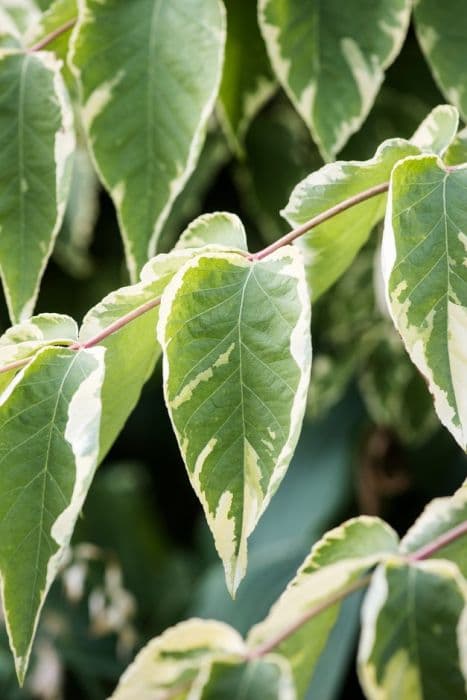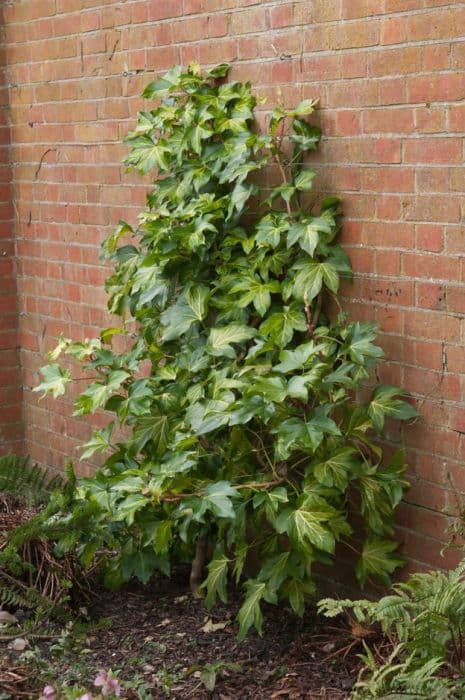Five-leaf Aralia Eleutherococcus sieboldianus

ABOUT
Eleutherococcus sieboldianus, commonly known as five-leaf aralia, is a deciduous shrub known for its distinctive foliage and structural interest in the landscape. Its leaves are palmately compound, typically comprising five leaflets emanating from a central point, much like the fingers of a hand. The leaflets are oval to lance-shaped, with serrated edges, giving them a somewhat jagged appearance. They are a rich green color, providing a lush, dense canopy during the growing season. In the spring and summer, the five-leaf aralia produces small, inconspicuous clusters of flowers. These flowers are usually white or greenish and may go unnoticed given their size and color blending with the foliage. Following the flowering period, the plant may produce blackish-purple berries, which can add visual interest and attract wildlife to the garden. The stems of the plant are covered with bristly spines that can dissuade animals from browsing on it. These spines also contribute to the plant's textural quality. Overall, five-leaf aralia has an upright, spreading growth habit, which makes it a useful plant in the landscape for creating visual barriers or as a distinctive accent specimen. The texture, unique leaf arrangement, and occasional berries make this shrub a versatile choice for gardeners looking to add variety to their plantings.
About this plant
 Names
NamesFamily
Araliaceae
Synonyms
Five-Leaf Aralia, Siebold's Aralia, Five-Leafed Aralia, Japanese Aralia
Common names
Acanthopanax sieboldianus, Eleutherococcus sieboldianus var. seoulense, Eleutherococcus sieboldianus var. chiisanensis
 Toxicity
ToxicityTo humans
Five-leaf Aralia is not commonly reported to be toxic to humans. However, as with any plant, individuals may experience allergic reactions or sensitivities. In general, it is advisable to avoid ingesting plants that are not known to be safe for consumption, as they may cause gastrointestinal discomfort or other adverse reactions in some people.
To pets
Five-leaf Aralia is not widely known to be toxic to pets, but caution is still recommended as individual animals may react differently to certain plants. In the absence of specific toxicity information, it's best to prevent your pets from ingesting this plant to avoid potential gastrointestinal upset or other negative health effects that could arise from eating non-food items.
 Characteristics
CharacteristicsLife cycle
Perennials
Foliage type
Deciduous
Color of leaves
Green
Height
7 feet (2.13 meters)
Spread
6 feet (1.83 meters)
Plant type
Shrub
Hardiness zones
4
Native area
Japan
Benefits
 General Benefits
General Benefits- Decorative Appeal: Eleutherococcus sieboldianus, commonly known as Five-leaf Akebia, adds an aesthetic touch to landscapes with its twining vines and compound leaves.
- Shade Provider: With its climbing habit, Five-leaf Akebia forms a natural canopy that can create shaded areas in gardens or over arbors and pergolas.
- Fragrance: The plant produces subtle yet pleasing fragrances from its small purple flowers, contributing to a sensory garden experience.
- Edible Parts: The fruits of Five-leaf Akebia are sometimes edible and can be used in traditional East Asian cuisine for their unique taste.
- Wildlife Attraction: Its flowers attract pollinators such as bees and butterflies, enhancing the health and biodiversity of the garden ecosystem.
- Growth Coverage: Five-leaf Akebia can be used to cover unsightly structures like walls or fences, providing a quick and attractive way to enhance privacy.
 Medical Properties
Medical Properties- Adaptogenic effects: Eleutherococcus sieboldianus, commonly known as Five-leaf Akebia, has been investigated for its potential adaptogenic properties, which could help the body withstand various stressors.
- Anti-inflammatory activity: Compounds within Five-leaf Akebia may have anti-inflammatory effects, which could assist in reducing inflammation in the body.
- Immune system modulation: There is some evidence to suggest that the plant may play a role in modulating the immune system, potentially influencing immune responses.
- Antioxidant properties: Like many plants, it may contain antioxidants, which protect cells from damage caused by free radicals.
 Air-purifying Qualities
Air-purifying QualitiesThis plant is not specifically known for air purifying qualities.
 Other Uses
Other Uses- Eleutherococcus sieboldianus, commonly known as five-leafed aralia, can be utilized as a natural barrier due to its dense and sprawling growth habit, which can deter unauthorized entry into private properties.
- The plant's dense foliage can be used for creating privacy screens in gardens, effectively blocking views from neighbors or passersby.
- Five-leafed aralia's woody stems can be harvested and used in the creation of small decorative items or as support stakes in gardening.
- Its attractive, spiky leaves can be used as a textural contrast in floral arrangements and bouquets.
- The plant's resilience to urban pollution makes it suitable for urban landscaping to add greenery in cities with poor air quality, apart from its air purifying properties.
- Five-leafed aralia can be trained to grow on trellises and arbors, providing an ornate and natural archway for gardens and paths.
- The interesting form and foliage of the plant can be utilized in oriental-themed garden designs, contributing to an authentic aesthetic.
- In areas where erosion control is necessary, the extensive root system of Eleutherococcus sieboldianus can help stabilize soil and prevent erosion.
- As a resilient deciduous shrub, it can be planted in reforestation projects, especially in areas with challenging growing conditions.
- Some cultures might use the bark and branches of the shrub for crafting traditional tools or as fuel for fires in outdoor cooking or rituals.
Interesting Facts
 Feng Shui
Feng ShuiThe Fiveleaf Akebia is not used in Feng Shui practice.
 Zodiac Sign Compitability
Zodiac Sign CompitabilityThe Fiveleaf Akebia is not used in astrology practice.
 Plant Symbolism
Plant Symbolism- Adaptability - Eleutherococcus sieboldianus, commonly known as Five-leaf Akebia, represents adaptability due to its robust nature and ability to thrive in various conditions.
- Resilience - The Five-leaf Akebia symbolizes resilience, as it can often tolerate harsh environments and recover from damage.
- Vitality - With its vigorous growth habit, the Five-leaf Akebia is often associated with vitality and strong life force.
- Protection - In some cultures, the tough, woody vines of the Five-leaf Akebia are seen as symbols of protection, providing a natural barrier when grown.
- Connection - The intertwining growth pattern of its vines can represent the connection between people and the intertwining of fates.
 Water
WaterThe Five-leaf Acanthopanax requires moderate watering to maintain uniformly moist soil. During active growth in spring and summer, watering approximately once a week with about a gallon of water is ideal. Cut back watering in the cooler months of fall and winter, reducing to every other week or less, depending on the plant's environment and the humidity levels. Always check the soil moisture before watering; the top inch should be dry to the touch. Overwatering or allowing the plant to sit in water can lead to root rot, so ensure proper drainage.
 Light
LightThe Five-leaf Acanthopanax thrives in partial shade to full sun. It can tolerate direct sunlight but prefers a location that receives dappled light throughout the day. Avoid harsh midday sun which can scorch the leaves. The ideal spot would provide morning sun and afternoon shade, or filtered light under the canopy of taller trees.
 Temperature
TemperatureThe Five-leaf Acanthopanax is hardy and can tolerate a range of temperatures. However, it prefers a temperature range between 60 to 80 degrees Fahrenheit for optimal growth. It can survive minimum winter temperatures down to 0 to -10 degrees Fahrenheit but should be protected from harsh frost. The plant's tolerance to heat is quite high, and it can endure up to about 90 degrees Fahrenheit without any significant stress.
 Pruning
PruningPruning the Five-leaf Acanthopanax is done to shape the plant, remove any dead or damaged branches, and promote healthy growth. It's best to prune in late winter or early spring before new growth begins. Occasional thinning may be necessary to maintain the desired form and allow light and air to penetrate the plant, which can be done every couple of years. Pruning can also be used to control the size of the plant if space is an issue.
 Cleaning
CleaningAs needed
 Soil
SoilFive-leaf Akebia prefers a well-draining soil mix with compost and perlite, having a pH range of 6.0-7.5 for optimal growth.
 Repotting
RepottingFive-leaf Akebia should be repotted every 2-3 years or when it outgrows its current pot, ensuring room for continued growth.
 Humidity & Misting
Humidity & MistingFive-leaf Akebia thrives in moderate to high humidity levels but is adaptable to average home humidity conditions.
 Suitable locations
Suitable locationsIndoor
Grow Five-leaf Akebia in bright, indirect light with regular watering.
Outdoor
Plant Five-leaf Akebia in partial shade and well-draining soil.
Hardiness zone
4-9 USDA
 Life cycle
Life cycleEleutherococcus sieboldianus, commonly known as Five-leaf Aralia, begins its life cycle as a seed, often dispersed by animals or natural elements. Upon germination, the seedling emerges, typically in the spring, and establishes itself with a rudimentary root system and shoots. As the plant enters the vegetative stage, it develops a more extensive root system and produces compound leaves that continue to grow and provide energy through photosynthesis. This perennial shrub may also develop thorns for protection during its growth. After reaching maturity, which can take several years, Five-leaf Aralia produces small, umbellate flowers during the summer, which are followed by blackish purple berry-like fruits that mature by autumn. These fruits contain seeds which, when dispersed, allow the life cycle to begin anew.
 Propogation
PropogationPropogation time
Spring-Early Summer
The most popular method of propagating Eleutherococcus sieboldianus, commonly known as Fiveleaf Acanthopanax, is by seed. The best time to sow the seeds is in late winter or early spring. Initially, the seeds require a period of cold stratification—a process that simulates natural winter conditions to break dormancy. This can be done by mixing the seeds with moist sand and refrigerating them at about 40 degrees Fahrenheit (4 degrees Celsius) for 2-3 months. After the stratification period, the seeds are sown in a well-draining soil mix, lightly covered with soil, and kept at a consistent temperature of approximately 70 degrees Fahrenheit (21 degrees Celsius). Germination may be slow and uneven, but once the seedlings emerge and reach a sufficient size, they can be transplanted into individual pots or directly into the garden at a location that receives partial to full shade.









